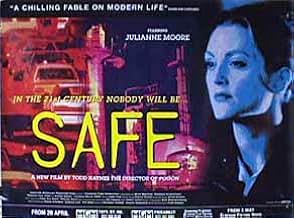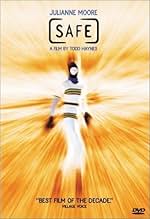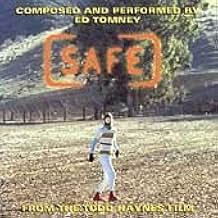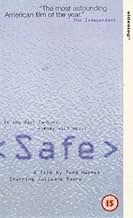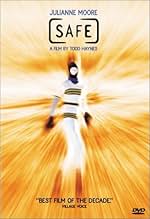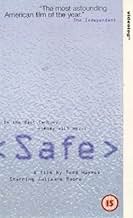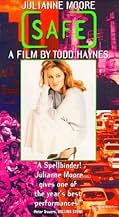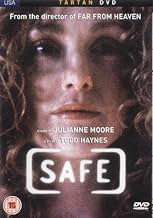IMDb रेटिंग
7.1/10
19 हज़ार
आपकी रेटिंग
इन उपनगरों में एक समृद्ध और अलौकिक गृहिणी कई रासायनिक संवेदनशीलता का विकास करती है.इन उपनगरों में एक समृद्ध और अलौकिक गृहिणी कई रासायनिक संवेदनशीलता का विकास करती है.इन उपनगरों में एक समृद्ध और अलौकिक गृहिणी कई रासायनिक संवेदनशीलता का विकास करती है.
- पुरस्कार
- 4 जीत और कुल 13 नामांकन
Martha Velez
- Fulvia
- (as Martha Velez-Johnson)
Chauncey Leopardi
- Rory
- (as Chauncy Leopardi)
Allan Wasserman
- Client
- (as Alan Wasserman)
Jean St. James
- Client's Wife
- (as Jean Pflieger)
फ़ीचर्ड समीक्षाएं
I watched Safe for our coverage of 1980s's health movements and the AIDS virus with a special eye for the conflict between New Age healers and "the medical profession." Safe connects so well with both; although there's no real homosexuality anxieties in the film, AIDS seem the unconquerable illness penetrating the lives of happy suburban people.
First of all, Julianne Moore is absent in the film. Her character, Carol White, is a model, rich California suburban housewife. We notice how absent she is from the moment that sex with her husband produces nothing in her, but she goes through the motions of kissing him and petting him afterwards. She has mechanical conversations with friends, with mother, with cleaning lady in her ultramodern, lush, carpeted, fashionably lit house with gardens surrounding it and police patrol by night. She goes to her workouts, cleaners, and arranges furniture.
This is a really tragic film. It's also brilliantly shot, edited, acted, and its sets are so appropriate. The use of teal and sky blue becomes numbing, anesthetizing in Carol's home, as does the harsh lighting of the doctor's office and the hospital. The Wrenwood Center itself resembles where Deckard would have gone at the end of Blade Runner as the orig. end credits seemed to indicate: mountains and nature as an antidote to the city.
However, it's not URBAN life that seems to be killing Carol- it's SUBURBAN life, it's Northern California, it's fruit diets, mini-malls, 80s music playing in health clubs, housewifes, gardens, pools, teal green couches, endless lines of cars, power lines, and street lights. It's dismal, and her family life is no big help having no real life to it.
At one point, in a really wrenching scene, Carol cries, looks at Greg from the bed and asks "Where am I? Right now?" He responds flatly but tenderly, "You're in Carol and Greg's house." She only cries more.
The question is: what is really wrong with Carol White? Did she succumb to depression and make herself a psychosomatic illness? Is she really sick and dying? Is she just afraid of living? It seems to me the more that Carol is told that she is the only one with the power to cure herself, the less power she seems to have. The final monologue where she stands in front of the group and discusses how far she's come is inarticulate, random, unthought, and not a good sign.
The acting is done well for its purposes, especially by Peter Dunn, the leader. He creates an interesting portrait of a man who is so determined to be a victim that he's created people who are dependent on him. Peter is the only dynamic presence in the film, but even he wants peace, love, and tranquility in our hearts. That doesn't seem to feed Carol.
This film reminded me of Koyaanisqatsi, visions of emptiness and life out of balance. Carol looks out her car window at the highways and powerlines and headlights, and she reminded me of someone watching that film, fearing technology. Yet even retreating from technology is not an ALTERNATIVE: it's a sign of defeat, isn't it?
The film doesn't offer solutions- only one of the most frightening, eerie, and numbing indictments of suburbia and the New Age that I have ever seen. It puts its images, sets, sounds, actors into a collective vision of decay, expressed through the decline of the model suburban housewife. See it, but don't look for answers or happy endings.
First of all, Julianne Moore is absent in the film. Her character, Carol White, is a model, rich California suburban housewife. We notice how absent she is from the moment that sex with her husband produces nothing in her, but she goes through the motions of kissing him and petting him afterwards. She has mechanical conversations with friends, with mother, with cleaning lady in her ultramodern, lush, carpeted, fashionably lit house with gardens surrounding it and police patrol by night. She goes to her workouts, cleaners, and arranges furniture.
This is a really tragic film. It's also brilliantly shot, edited, acted, and its sets are so appropriate. The use of teal and sky blue becomes numbing, anesthetizing in Carol's home, as does the harsh lighting of the doctor's office and the hospital. The Wrenwood Center itself resembles where Deckard would have gone at the end of Blade Runner as the orig. end credits seemed to indicate: mountains and nature as an antidote to the city.
However, it's not URBAN life that seems to be killing Carol- it's SUBURBAN life, it's Northern California, it's fruit diets, mini-malls, 80s music playing in health clubs, housewifes, gardens, pools, teal green couches, endless lines of cars, power lines, and street lights. It's dismal, and her family life is no big help having no real life to it.
At one point, in a really wrenching scene, Carol cries, looks at Greg from the bed and asks "Where am I? Right now?" He responds flatly but tenderly, "You're in Carol and Greg's house." She only cries more.
The question is: what is really wrong with Carol White? Did she succumb to depression and make herself a psychosomatic illness? Is she really sick and dying? Is she just afraid of living? It seems to me the more that Carol is told that she is the only one with the power to cure herself, the less power she seems to have. The final monologue where she stands in front of the group and discusses how far she's come is inarticulate, random, unthought, and not a good sign.
The acting is done well for its purposes, especially by Peter Dunn, the leader. He creates an interesting portrait of a man who is so determined to be a victim that he's created people who are dependent on him. Peter is the only dynamic presence in the film, but even he wants peace, love, and tranquility in our hearts. That doesn't seem to feed Carol.
This film reminded me of Koyaanisqatsi, visions of emptiness and life out of balance. Carol looks out her car window at the highways and powerlines and headlights, and she reminded me of someone watching that film, fearing technology. Yet even retreating from technology is not an ALTERNATIVE: it's a sign of defeat, isn't it?
The film doesn't offer solutions- only one of the most frightening, eerie, and numbing indictments of suburbia and the New Age that I have ever seen. It puts its images, sets, sounds, actors into a collective vision of decay, expressed through the decline of the model suburban housewife. See it, but don't look for answers or happy endings.
This truly is one of the rarest commodities in the cinema pantheon; a film that conveys multiple plot angles, each as disturbing as the next, yet in a most quiet and understated fashion. Watching the WASPish, vacant, and utterly clueless Carole (played by chameleon beyond compare Julianne Moore) slowly morph from armpiece San Fernando wife to a fragile shell of a person, may not be an experience you will enjoy at first, as a close friend of mine said after viewing "There's no damn way I'd pay eight bucks for that!". Just give it a day or two, for never has there been a film (at least not until The Blair Witch came along) that has a way of seeping into your subconscious as this. That same friend, who so soundly poo-pooed it, later confided to me that the final scenes, which show what Carole had become, were haunting him at work and rest. It is an interesting study in the effectiveness of true psychologically jarring film making, where much is left to the audiences imagination - including the root of this strange affliction, the viability of these help groups, and indeed Carole's perception of all that is happening to and around her.
The soundtrack is perfect - simple eery piano over looming synth. The use of the camera is as economical as it is effective - the less shown the more we think, with broad extreme long shots used primarily in the beginning, showing that Carole doesn't seem to belong in her own home. Yet this film's greatest triumph is, for all that she has been through, and the weak diseased person she became, Carole appears to find happiness and respect for herself. Without a second thought that is the most disturbing possibility I could, or would want to, imagine. Safe may very well be a film that does not lend itself to repeated viewing. But that's fine, because it only takes one dose of this quietly sad and ghostly film to haunt you ever
The soundtrack is perfect - simple eery piano over looming synth. The use of the camera is as economical as it is effective - the less shown the more we think, with broad extreme long shots used primarily in the beginning, showing that Carole doesn't seem to belong in her own home. Yet this film's greatest triumph is, for all that she has been through, and the weak diseased person she became, Carole appears to find happiness and respect for herself. Without a second thought that is the most disturbing possibility I could, or would want to, imagine. Safe may very well be a film that does not lend itself to repeated viewing. But that's fine, because it only takes one dose of this quietly sad and ghostly film to haunt you ever
Todd Haynes's modern melodrama, Safe (1995), has proven to be quite a controversial film for debate amongst film critics. Those who enjoyed the film defended it as an excellent critique on the twentieth century while others claimed it to be slow and boring. Although, as the study of film progresses Safe is being viewed under a differently light and becoming more accepted amongst American movie goers, developing what looks like the beginnings of a cult following. I would side with those who agree that the film is an excellent critique of the twentieth century although that is not my focus of analysis for this commentary.
The real focus of analysis involves one extremely short scene: where Carol White comes home and stares at the new furniture after it has been brought into the house a second time, which was about half way through the film. The mise-en-scene in this short five to ten second shot is extraordinary in its capture of the mood or in Carol White's case the sickness behind suburban life.
The new couch alone was the most powerful aspect of mise-en-scene. There it was, black in color, square in shape, perfectly spaced between the walls and lamps. The couch is empty and unused yet filling in space and suburban peace of mind. It is the focus of the entire shot, forcing the audience to stare on waiting for a reaction, some kind of acknowledgment from Carol White. The couch, to me, has essentially become a reflection of Carol White, fitting since her name is just as blank and lifeless as the couch.
I also thought the lighting of the room was crucial in creating the setting for the couch. The low key lighting of the enclosed room shuts out all life, helping to create that dead environment which Carol White cannot seem to escape. The darker scene really blurs the edges of the couch and the corners of the walls, forming a cave like design. This particular aspect of light really adds to the frighteningly scary mood which is most commonly felt and scene by audience members, but never really thought about or understood.
Sound and lack of it really set the tone for hidden narratives of suburban horror. The beginning of the short scene depicts Carol White walking in the darkened room to see the new couch, and only her light footsteps are heard. After this there is complete silence for at least five to ten seconds. Since the scene did not have any muffled background sounds I found it to be quite useful in describing the silence in which Carol White lives her life. Even the furniture is louder than she.
The style of mise-en-scene in this scene is quite evident throughout the rest of the film, and really shows its importance as a tool in every cinematic genre. A film such as Safe demands attention to detail and a unique style when it comes to mise-en-scene. One should always take the time to stop and enjoy the symbols, messages, and hidden narratives behind mise-en-scene.
The real focus of analysis involves one extremely short scene: where Carol White comes home and stares at the new furniture after it has been brought into the house a second time, which was about half way through the film. The mise-en-scene in this short five to ten second shot is extraordinary in its capture of the mood or in Carol White's case the sickness behind suburban life.
The new couch alone was the most powerful aspect of mise-en-scene. There it was, black in color, square in shape, perfectly spaced between the walls and lamps. The couch is empty and unused yet filling in space and suburban peace of mind. It is the focus of the entire shot, forcing the audience to stare on waiting for a reaction, some kind of acknowledgment from Carol White. The couch, to me, has essentially become a reflection of Carol White, fitting since her name is just as blank and lifeless as the couch.
I also thought the lighting of the room was crucial in creating the setting for the couch. The low key lighting of the enclosed room shuts out all life, helping to create that dead environment which Carol White cannot seem to escape. The darker scene really blurs the edges of the couch and the corners of the walls, forming a cave like design. This particular aspect of light really adds to the frighteningly scary mood which is most commonly felt and scene by audience members, but never really thought about or understood.
Sound and lack of it really set the tone for hidden narratives of suburban horror. The beginning of the short scene depicts Carol White walking in the darkened room to see the new couch, and only her light footsteps are heard. After this there is complete silence for at least five to ten seconds. Since the scene did not have any muffled background sounds I found it to be quite useful in describing the silence in which Carol White lives her life. Even the furniture is louder than she.
The style of mise-en-scene in this scene is quite evident throughout the rest of the film, and really shows its importance as a tool in every cinematic genre. A film such as Safe demands attention to detail and a unique style when it comes to mise-en-scene. One should always take the time to stop and enjoy the symbols, messages, and hidden narratives behind mise-en-scene.
Safe is perhaps a tad too ambiguous for its own good. The film focuses on a suburban housewife (Julianne Moore) who feels sick for no reason. Her doctor suggests psychological treatment, but she finds more comfort in the idea that her sickness is caused by environmental factors, such as car fumes and the like. Haynes never answers the question of what is really affecting Moore. One moment you're sure it's psychological, then physical symptoms displayed by the woman are undeniable. It's not that I really wanted the questions answered, but the constant toying with the audience does become a strain, especially as the film runs for two hours and not much happens. There's also the possibility that the story isn't meant to represent reality, but instead it might be allegorical. This makes it all the more difficult to unravel. I know I sound sort of negative in this review, but I did like it. I don't think it works completely, but I found it fascinating. One reason it does work at all is that Haynes' major goal seems to want to put us inside Moore's head. It shows us what it would be like to suffer and not know why, and how comfortable it might be to, say, join a cult, which is basically what she does in the end. Not entirely satisfying, but definitely well worth a look.
Julianne Moore is one of my favorite actresses and that's the reason I decided to watch this one.
This film is labeled as Drama/Thriller. Well, the drama's here, no doubt, as Carol White (Moore) slowly begins to succumb to the multiple effects of all types of pollution that pervade our technocratic consumer societies. There's psychological drama also as her husband, Greg (Xander Berkeley) tries to come to some understanding about Carol and how his marriage seems to be slowly disintegrating. And, there's drama also when Carol reacts violently to various chemicals, such that she is hospitalized and undergoes a battery of tests...
But... Thriller? Not at all, not by a long shot.
This is something better than mere thrills at one level, it's a modern horror story that we are all living, because we are all part of this petrochemical world that we cannot reasonably escape. At another level, it's also the horror that results when a person decides to dislocate from the polluted world we all live in and construct another world within the mind. The end result of such an act is usually madness... eventually.
Beautifully acted by all the players, so that it seems that they aren't acting; it is, after all, all too real, is it not? The musical background is simply stunning brooding, dark, menacing, and reminiscent of a David Lynch soundtrack. Visually, for the first half, you are battered with repetitive images of unending lines of traffic, excessive noise, mindless activities, rampant consumerism all designed to reflect the battered mind and body of Carol as she struggles to determine her future in a world that is increasingly threatening.
How she does that forms the second half. Does she succeed? I could say Yes and No, but I'll leave it up to you to decide when you see it. Enjoy...if you can!
This film is labeled as Drama/Thriller. Well, the drama's here, no doubt, as Carol White (Moore) slowly begins to succumb to the multiple effects of all types of pollution that pervade our technocratic consumer societies. There's psychological drama also as her husband, Greg (Xander Berkeley) tries to come to some understanding about Carol and how his marriage seems to be slowly disintegrating. And, there's drama also when Carol reacts violently to various chemicals, such that she is hospitalized and undergoes a battery of tests...
But... Thriller? Not at all, not by a long shot.
This is something better than mere thrills at one level, it's a modern horror story that we are all living, because we are all part of this petrochemical world that we cannot reasonably escape. At another level, it's also the horror that results when a person decides to dislocate from the polluted world we all live in and construct another world within the mind. The end result of such an act is usually madness... eventually.
Beautifully acted by all the players, so that it seems that they aren't acting; it is, after all, all too real, is it not? The musical background is simply stunning brooding, dark, menacing, and reminiscent of a David Lynch soundtrack. Visually, for the first half, you are battered with repetitive images of unending lines of traffic, excessive noise, mindless activities, rampant consumerism all designed to reflect the battered mind and body of Carol as she struggles to determine her future in a world that is increasingly threatening.
How she does that forms the second half. Does she succeed? I could say Yes and No, but I'll leave it up to you to decide when you see it. Enjoy...if you can!
क्या आपको पता है
- ट्रिवियाWhen it came time for Julianne Moore to record the director's commentary for the 2003 DVD release, this was the first time the lead actress had seen the movie in its entirety.
- गूफ़Although this film was explicitly set in 1987, while Carol is driving on the highway, she passes a burgundy 1992 Cadillac de Ville.
- भाव
Carol White: [about her declining health] I'm sorry. I know it's not normal but I can't help it.
टॉप पसंद
रेटिंग देने के लिए साइन-इन करें और वैयक्तिकृत सुझावों के लिए वॉचलिस्ट करें
- How long is Safe?Alexa द्वारा संचालित
विवरण
- रिलीज़ की तारीख़
- कंट्री ऑफ़ ओरिजिन
- भाषाएं
- इस रूप में भी जाना जाता है
- A salvo
- फ़िल्माने की जगहें
- उत्पादन कंपनियां
- IMDbPro पर और कंपनी क्रेडिट देखें
बॉक्स ऑफ़िस
- बजट
- $10,00,000(अनुमानित)
- US और कनाडा में सकल
- $5,12,245
- US और कनाडा में पहले सप्ताह में कुल कमाई
- $15,830
- 25 जून 1995
- दुनिया भर में सकल
- $5,12,558
इस पेज में योगदान दें
किसी बदलाव का सुझाव दें या अनुपलब्ध कॉन्टेंट जोड़ें



